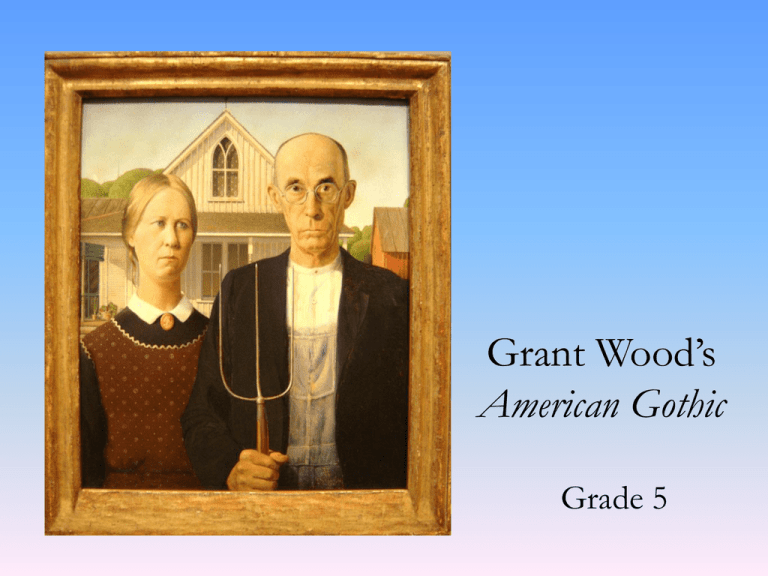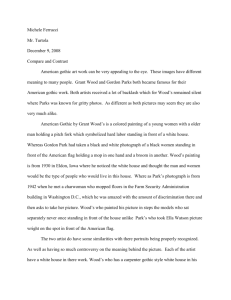American Gothic and the Art of Parody
advertisement

Grant Wood’s American Gothic Grade 5 Grant Wood was born in Anamosa Iowa in 1891. He lived on a small farm for the first 10 years of his life. Then after his father died in 1901, the family moved from their farm to Cedar Rapids, a town so big that, according to Grant’s older brother, “it’s little finger is bigger than Anamosa.” Grant’s love for art developed early. He drew everything he saw in nature around him. He drew farm animals, houses, trees and chickens—his favorite. His art supplies consisted of cardboard from cracker boxes and charred black sticks from the cooking stove. When Grant was in 8th grade, he entered one of his drawings in a nationwide art contest. The picture of oak leaves won a prize of $5. Grant began selling his paintings during high school. He sold them in order to buy art supplies like watercolor paints and India ink. After Grant graduated from high school, he went to Minneapolis to go to art school. It was while he was in Minneapolis that Grant’s style of painting began to take form. He liked to paint carefully, using crisp lines and solid shapes. He didn’t like the styles that were popular at the time such as Impressionism. Waterlilies Claude Monet Young Corn Grant Wood Grant’s style of painting became known as Regionalism. This style was popular in the 1920’s and 1930’s. Regionalism got its name from the artists who painted the natural landscape and the people of the Midwest, especially Iowa. Other Regionalist artists wrote stories and poems set in or about the Midwest. Regionalism is sometimes called the first uniquely American style of art. Iowa Regionalism was unique in its time because it showed familiar subjects in realistic ways. The other popular styles at that time were abstract, painting familiar subjects like trees, in strange forms and colors. Wood Fall Plowing Grant Wood Grant’s art was based on the people, places and events he saw around him as a young boy on his family’s farm. His paintings featured family members, friends, and places from his youth. Who do you think is the woman in Woman with the Plants? Stone City, Iowa features a nearby farming community. American Gothic features his sister and his dentist! Grant’s paintings resemble photographs, but something is different. The paintings are detailed and realistic, and have qualities of a young boy’s memories. The trees are more rounded and puffier than a photograph. Paul Revere’s Ride Grant Wood Grant’s most famous painting is titled, American Gothic. This painting was done in 1930 and shows a farmer and his daughter in front of a small farmhouse. The bullet-shaped window in the background is where the name of the painting came from. The window looks like windows on the large churches Germany built in the Gothic tradition of architecture. American Gothic was the first painting by Grant to receive attention outside of Iowa. Up to 1930, Grant’s work was well-known within his community and had received awards at Iowa state fairs, but few people outside of Iowa knew of his art. This all changed when American Gothic was shown at a Chicago art exhibition in 1930. The painting won an award and was purchased by the Art Institute of Chicago where it is today! American Gothic has become a well-known image of Americans and Midwesterners, especially Iowans. The picture has been used in many different places: on magnets, on ties, on tshirts, and in political cartoons. Many people (and animals) have replaced the original pair: presidents and their wives, Kermit the Frog and Miss Piggy, movie stars, and cartoons! The original pair has been placed in many different settings: underwater, on the beach, in outer space, etc. This particular type of art is called a parody. A parody is a funny imitation (copy) of a picture, song, or story, intended to poke some affectionate fun of someone or something. Other works of art have been poked fun of. Marcel Duchamp painted a mustache on a postcard of the Mona Lisa! These are not the only parodies! Check out these versions of The Scream! Can you guess what famous work this is poking fun of ? When someone chooses to make a parody of your work of art it is quite an honor. It means that your work is recognized throughout the world. I wonder what Leonardo DaVinci would have thought of this parody? Student Works: Review Questions • What country is Grant Wood from? • What is the name of Grant Wood’s most famous painting? • Where is that painting located now? • What architectural detail helped give the painting its name? • Why are American Gothic and the Mona Lisa often parodied?







